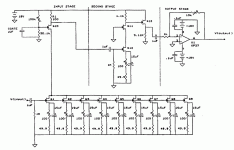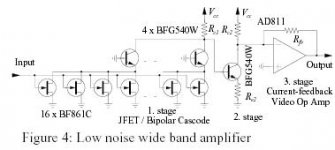Don't know if anyone noticed, but Erno Borbely has three new articles on JFETs, noise, etc. on his website...
See top three links here: http://www.borbelyaudio.com/special_articles.asp
See top three links here: http://www.borbelyaudio.com/special_articles.asp
jackinnj said:
My kids used to tell me that "ASSUME" means "you mad an *** outta me".
Williams is truely one of the old codgers of analog -- starting out when Fairchild was knee-high to a grasshopper. Even dedicated a book to Widlar.
One thus ASSUMES that 1*10e-9 means that it succesfully competes with the noise level.
please to read Mr. Williams treatise on noise measurement -- the folks who design space radio-telescopes, ultrasound equipment, sonar buoys, etc. swear by it.
äh, I was ASSUMING that its not low noise like what
Thijs is talking about, ie. 0.33nV/hz as i can see 1k resistances on circuitry and LT1230's. Enough low noise anyways, I agree on that if it was your point.
read Mr. Williams treatise on noise measurement
I'm all ears... got a ref. for me on that one?
Wow! A jFET with 0.33 nV/Hz ! Does it have a complement? Idss?
Price - is it practical? affordable? available? eek:
Cheers,
Greg
Price - is it practical? affordable? available? eek:
Cheers,
Greg
If you parallel 10 JFETs 2SK369 with a typical noise voltage of 0.75nV / sqrt(Hz) at 5mA you can obtain an equivalent input noise voltage of 0.24nV / sqrt(Hz).
10x 2sk369 in parallel might be a fun project to do but... would give me allmost 1nF input capacitance...... I think the good thing about the 2sk152 is the low Ciss: 8pF .. for the 2sk369 this is 75pF
grz,
T
grz,
T
jackinnj said:"An Ultra Low Noise Amplifier for superconductive Detectors" -- each 2sk152 is set to draw 10 ma. so this thing really cooks -- note that for audio there are quite few things which have to be "fixed":
Interesting. Seems like Q10 would really cook at 90mA.
And here is 16 parallel JFETs. Any examples of something outrageous like 32 parallel JFETs?
Attachments
yes, the authors did point out that some of these devices would really cook. each amplifier section reduces the noise by SQRT(K) where K is the # of amplifying sections, but it also increases the current by K^2. the authors determined that 9 was the optimal number of amplifying sections.
tschrama said:10x 2sk369 in parallel might be a fun project to do but... would give me allmost 1nF input capacitance...... I think the good thing about the 2sk152 is the low Ciss: 8pF .. for the 2sk369 this is 75pF
grz,
T
Hi low noise gurus,
AFAIK this device is about the lowest noise device
currently available.
http://www.interfet.com/pdf/DS_IF3602.pdf
On my more complete data sheets it specs about 0.28nV/rt Hz
at 1k
As you would suspect the transconductance is through the
roof at many 100's of mS
Unfortunately, as you would also expect, the capacitance is
also through the roof.
However, with careful design it might be useful. I'm also
not very convinced it would sound any good.
I have a couple but have never used them, they are
very expensive little puppies too.... maybe someday
I'll do something with them 🙂
Cheers,
Terry
Hi Terry!
how are you? Good to hear from you! Thanks for the datasheet, i'll look into it. Allthough the capacitance is high, there's is little use in parralelling more devices, so a practicle design should be possible... I think.....
cya,
Thijs
how are you? Good to hear from you! Thanks for the datasheet, i'll look into it. Allthough the capacitance is high, there's is little use in parralelling more devices, so a practicle design should be possible... I think.....
cya,
Thijs
Terry Demol said:
http://www.interfet.com/pdf/DS_IF3602.pdf
On my more complete data sheets it specs about 0.28nV/rt Hz
at 1k
.
.
.
I have a couple but have never used them, they are
very expensive little puppies too.... maybe someday
I'll do something with them 🙂
Cheers,
Terry
This datasheet provides gm v Idss.
http://www.interfet.com/pdf/P_NJ3600L.pdf
Input capacitance and current draw aside, I wonder what the lower limit is for input referred noise (300 d K). Could a person acheive 92pV/rt Hz with 32 2sk170's in parallel? (10mA per JFET, shielded enclosure, etc.)
I wonder what the lower limit is for input referred noise (300 d K). Could a person acheive 92pV/rt Hz with 32 2sk170's in parallel? (10mA per JFET, shielded enclosure, etc.)
Actually I was wondering something similar.. how about three 9W peltiers elements cascaded to provide deltaTemp of 190 K... ? shouldn't hat about halve the noise again?
tschrama said:
Actually I was wondering something similar.. how about three 9W peltiers elements cascaded to provide deltaTemp of 190 K... ?
Something tells me that it is much easier to quadruple the JFETs.
tschrama said:offcourse, but high frequency response suffers....
So are you going to try peltiers?
I did think about it, and it would be super cooolll... 😉 .. prices at farnellinone are about 50 Euro for each peltier element, but that is without power supply .... right now I'm just checking various publications and datasheet, i'll first make a SPICE design before I built anything. .. so I need SPICE model parameters.. I allready have the 2SK152 on order, I got about twenty 2Sk170 matched, and several alternatives on order or on sample request.
My very first objective will be to measure a MC-phono step-up amplifier, maybe by using the first stage of the N. Pass Pearl-phono stage...
Eventhough, for once, my financial situation is not llimiting a project, time and space (just moved to life togheter with my girl-friend) is .. My house is a mess, packed moving-boxes allaround, and my hobby-desk is dismanteled in parts
My very first objective will be to measure a MC-phono step-up amplifier, maybe by using the first stage of the N. Pass Pearl-phono stage...
Eventhough, for once, my financial situation is not llimiting a project, time and space (just moved to life togheter with my girl-friend) is .. My house is a mess, packed moving-boxes allaround, and my hobby-desk is dismanteled in parts

Erno Borberly has a couple of articles in this June's AudioXpress which implement a "paired" complementary JFET amplifier --
and by the way -- I modeled the SQUID ULN preamplifier and it would appear that it should oscillate around 10 MHz. 🙂 The author's principal area of interest seems to be 500Hz to a few kHz. They have a chart of the noise spectra, but it is from 1kHz to 100kHz -- I would like to see it from 100milli-Hz to 10Hz
and by the way -- I modeled the SQUID ULN preamplifier and it would appear that it should oscillate around 10 MHz. 🙂 The author's principal area of interest seems to be 500Hz to a few kHz. They have a chart of the noise spectra, but it is from 1kHz to 100kHz -- I would like to see it from 100milli-Hz to 10Hz
- Status
- Not open for further replies.
- Home
- Amplifiers
- Solid State
- low noise JFET, how about this one

